Collaboration with WHO

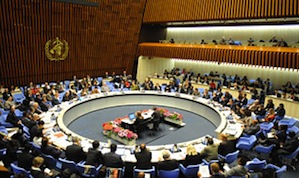
WHO Commitment
In 1994, the World Health Organization (WHO) declared that noma was a public-health problem, and recognized noma as a global disease, affecting mainly Africa and afflicting children aged between 0-6 years.
In 1998, WHO estimated the overall incidence of noma at over 140,000 cases a year, with a mortality rate of between 70 and 80%.
The WHO’s strategy for tackling the disease, inspired by Winds of Hope, is based on prevention and early detection; immediate treatment; information and public education; collection of epidemiological data; and finally the establishment of specialized centers for the treatment of the sequelae.
Since 2001, the WHO/AFRO has been operating a regional program to fight Noma, with the primary goal of eradicating this disease in the African region, which remains the hardest hit. This entails setting up and incorporating prevention and treatment of Noma cases into national oral health programs. In recent years, WHO/AFRO has bolstered its action to develop and implement national programs to fight Noma. There has been a veritable surge in these national programs with greater mobilization by the international community in the countries supported.
In May 2007, the World Health Assembly adopted a Resolution urging support for programs for the fight against Noma in countries affected by the disease.
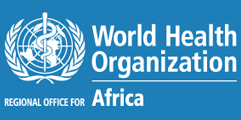
Agreements with WHO/AFRO
The funding of National Plans for the Fight against Noma (NPFNs) is the Foundation's main weapon. It has chosen to support straightforward programs with a strong multiplier effect for preventive information, early detection and primary health care.
It is vital that the Health Ministry in each country should have a national operational plan enabling it to conduct large-scale national campaigns for training health workers and raising social awareness, whilst at the same time supervising and coordinating all detection and treatment programs. Eventually, sustainable success in eliminating noma can be achieved by strengthening these national resources.
After facilitating the launch of the NPFN in Niger in 2000, Winds of Hope decided in 2002 to fund similar programs in Burkina Faso, Mali and Benin. Therefore, in 2003, the Foundation signed a 5-year partnership with the Regional Office of the World Health Organization for Africa (WHO / AFRO) providing a total budget of EUR 2 million (CHF 3 million at that time). In 2006, Togo and Senegal joined the group of countries supported by Winds of Hope.
So, currently, six countries in West Africa are being supported by the Winds of Hope Foundation with programs for training health workers to be able to recognize and treat the early signs of noma. The idea is to develop these pilot programs in the other African countries that are also affected by noma, malnutrition and lack of hygiene caused by extreme poverty.
Winds of Hope’s partnership with WHO / AFRO and the Ministries of Health to fight noma in sub-Saharan Africa has allowed national anti-noma programs to be launched that had originally been planned by WHO, but shelved for lack of funding. This is a first, since hitherto nobody had funded the implementation of prevention programs in direct collaboration with the health authorities.
In October 2010, a new phase in the partnership between the WHO Regional Office for Africa and Winds of Hope began. A new partnership agreement was signed for re-launching and revitalizing the regional program for combating noma, with a renewable annual budget of EUR 400,000.
• This tripartite partnership is structured as follows:
• The Ministry of Health draws up its national plan for fighting noma, submits it for approval and then implements it, activity by activity.
• The WHO corrects and validates the plans of each country and then provides operational, technical, logistical and financial monitoring. It also organizes an inter-country workshop, inviting local NGOs as observers.
• Winds of Hope approves the plans, provides funding for them, and supervises their implementation, notably through in-country assessment and coordination missions.
In this context, the preventative work in these countries has focused on reinforcing the capacity of local staff, in particular by training health workers, and developing campaigns of outreach, advocacy and social mobilization of village populations. In parallel, screening strategies have been developed in collaboration with health authorities and the NGOs present in the field, resulting in the immediate treatment of oral lesions at health centers and the immediate admission of children suffering from noma to ad-hoc clinics.
Coordination of the Regional Programme for the Fight against Noma (RPFN), which brings together six NPFNs, is provided by the regional coordinator for oral health and noma. This program is part of the fight against Non-Communicable Diseases (NCDs) led by the Disease Prevention and Control (DPC) Program Area in WHO’s Regional Office for Africa. The Noma Coordinator is responsible for financial and administrative management, as well as technical assistance to recipient countries for implementation of their programs. He also ensures that the Ministry of Health and WHO national office in each country coordinate their activities.
In each country, implementation of activities included in the national action plans is overseen by the NPFN coordinator in the Ministry of Health and his team. A focal point for Noma has also been designated in each country’s national WHO office, who is responsible for helping the national coordinator to finalize action plans, and with implementing the various stages of the planned activities. He also provides monitoring and supervision of these activities.
WHO/AFRO, located in Brazzaville, had named Dr. Charlotte Faty Ndiaye as RPFN coordinator for the partnership from 2003-2008. Following the renewal of the cooperation agreement in 2010, a new regional coordinator was appointed in the person of Dr. Benedict Varenne.
It takes approximately CHF 100,000 per year to fund the program for an entire sub-Saharan country, in which more than half the population lives below the poverty line. This is an inexpensive investment considering the highly leveraged effect these activities achieve in the fight against the consequences of extreme poverty, first and foremost amongst which is malnutrition.
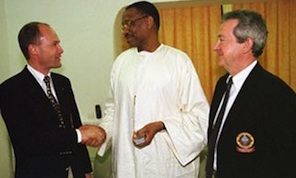
Regional Program for the Fight against Noma
The Regional Programme for the Fight against Noma (RPFN) aims at the elimination of Noma. Its main objectives can be summarized as the design, implementation, monitoring and evaluation of activities on the ground in the area of prevention: training of health workers, early detection and primary health care, education and social mobilization, epidemiological surveillance.
It also aims to ensure that recognition of Noma is included in training courses for health professionals at all levels. It takes account of the importance of community health in the fight against noma, as well as the role of its agents in the prevention and early detection of cases.
Support for the six beneficiary countries is coordinated technically by the WHO Regional Office for Africa and funded by the Winds of Hope Foundation. It involves the development, validation and implementation of a National Action Plan for the Fight against Noma (NPFN) in each country according to the following process:
• A national coordinator for the fight against noma is appointed by the Ministry of Health and is usually attached to the department responsible for non-communicable diseases (NCDs)
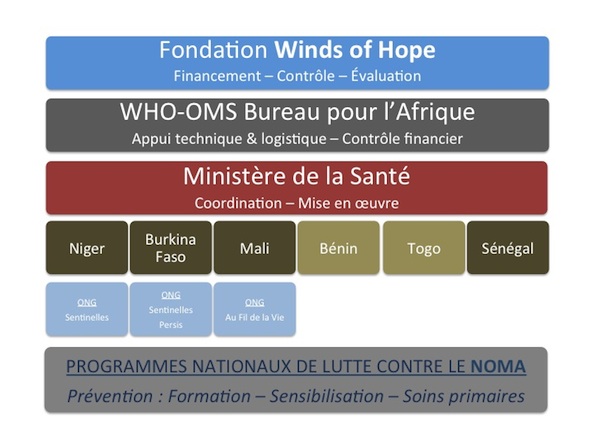 • An annual inter-country workshop, bringing together the coordinator, the NCD director and the head of the WHO office in each country enables stock to be taken of the program that is coming to an end, and goals to be set for the one that will follow.
• An annual inter-country workshop, bringing together the coordinator, the NCD director and the head of the WHO office in each country enables stock to be taken of the program that is coming to an end, and goals to be set for the one that will follow.
• Each country prepares its action plan, which is checked and corrected by the WHO for Africa before being approved, jointly with Winds of Hope.
• Each activity defined in the plan is the subject of a request for funds from the Ministry of Health to WHO. This application is reviewed and approved by the WHO office in the country, also called the “focal point”.
• The National Coordinator thus implements his action plan with the support of the WHO focal point, which is responsible for monitoring and controlling the balance between planned activities, requests, and effective implementation on the ground.
The NPFNs are designed around these five main component elements :
1. Reinforcement and development of capacity
Training in the field of prevention and treatment of noma are provided to community health workers (CHWs) and staff in health centers. Particular emphasis is placed on training staff who work in especially isolated villages, which are more likely to be affected by the scourge of noma. These courses are also available for to those in the public sector and civil society (associations, groups, NGOs) who are active in community health and the fight against noma.
Specifically, action consists of educating and training community health workers in successive cascades, from the national, down through the regional and district levels, to the local village level. These workers include staff in health facilities as well as traditional healers who are able to teach the rudiments of prevention and detection of the early symptoms of noma in every village of the country.
This component also includes activities that contribute to the integration of noma into the academic training of health professionals (initial or continuation training): doctors, dentists, surgeons, nurses, midwives, etc.
The choice of regions and health districts that will receive training is based on certain criteria, such as results achieved, endemic level and quality of care in cases of noma.
2. Early detection of cases and first aid
This component is aimed at the often isolated communities that are affected by the scourge of noma. In collaboration with them, the activities include screenings, systematic mouth inspections, and treatment of mouth sores in the target populations. These are carried out in nutritional rehabilitation centers and primary healthcare facilities.
These activities are carried out mainly by the medical staff of the country’s health services, but may also be organized by community volunteers. An up-to-date list of products, supplies and essential drugs required for these screening and first aid activities is kept (showing quantity and cost).
Depending on the number of cases detected and taken under treatment, and after consideration of the criteria mentioned in the previous component, a program of activities is designed and then implemented.
3. Raising of awareness and social mobilisation
The overall objective is to inform and alert the public and the health professionals so as to improve knowledge, fight against discrimination and promote behavioral changes in connection with noma. This is part of an approach to health promotion that aims ultimately at getting communities and individuals to become stakeholders in the fight against the disease.
Activities include organizing local, regional and national media campaigns (local radio, press, television, mobile cinema, etc.), advocacy and special events. These approaches, often made locally using national languages and involving the communities, have demonstrated their effectiveness in raising awareness and changing behavior. The forum theater, the mobile cinema, the radio hook-up, etc… all activities to be developed by entrusting them to associations, NGOs and other groups recognized for the seriousness of their approach.
4. Materials for training and education
To support the implementation of the previous components, educational and training materials of various kinds (notices, posters, booklets, boxes of pictures, songs, comic books, movies, etc..) need absolutely to be produced that are appropriate for the various target populations.
Countries will often have developed their own educational materials for this purpose. Aids that have proven their effectiveness are adopted and reproduced. Others are revised and updated. To reduce printing costs, work is carried out to harmonize some of the media across regions, whilst always respecting national traditions and religious beliefs.
5. Coordination, monitoring and evaluation
An essential component of the project is the work done by National Coordinators and their teams to lead, facilitate, coordinate, monitor and evaluate activities. These missions require frequent travel within the country.
The first two of the above components absorb more than half of the funds allocated by Winds of Hope
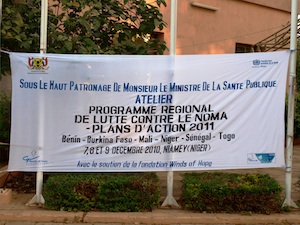
Inter-country workshops
Exchanging experiences, sharing best practices, explaining issues, reviewing the past, and defining the future ... these are the workshops' objectives.
Exchanging experiences, sharing best practices, explaining issues, reviewing the past, and defining the future ... these are the workshops’ objectives.
As part of the re-launch of collaboration with the WHO in 2010, an inter-country workshop was established for each of the regional noma plans that have been launched. These meetings, organized jointly by WHO and the Ministry of Health of the host country, normally last three days. Each of the countries supported takes turns to host the workshop, which has three representatives from each country. Each delegation consists of the National Noma Coordinator, together with the Head of NCD from the Ministry of Health and the WHO focal point for the country
The objectives of these workshops on activities for combating noma in the countries concerned are:
• Exchanging experiences accumulated over the years in the fight against noma
• Share best innovative and integrated practices, as well as teaching and training materials that have demonstrated their effectiveness,
• Explain the issues and the objectives of the RPFN.
• Draw up a balance sheet of activities in the past year and a consolidated balance sheet of activities since 2003
• Work on the plan of action against noma for the following year.
The workshops are usually opened by the Minister of Health of the host country and enjoy very good national media coverage.
The first workshop in Niamey was notable for the renewal of the NPFNs, with a harmonizing of their objectives. This has resulted in a significant improvement in their quality, and better monitoring of outcomes.
The main achievement of the second workshop in Ouidah was to reach agreement on a common definition of the roles and responsibilities of community health workers in the fight against noma.
December 2010 : Niamey (Niger) – lien rapport
November 2011 : Ouidah (Benin) – lien rapport
December 2012 : Brazzaville (Congo) – lien rapport
October 2013 : Dakar (Senegal) – available soon







